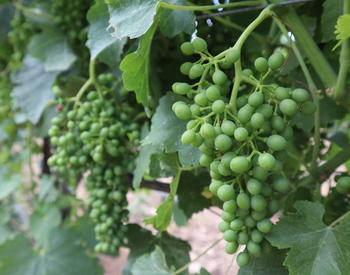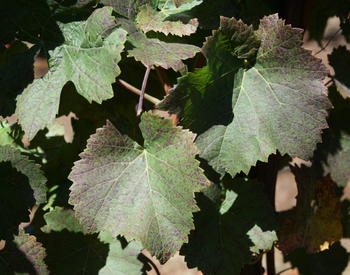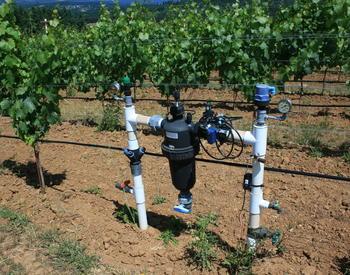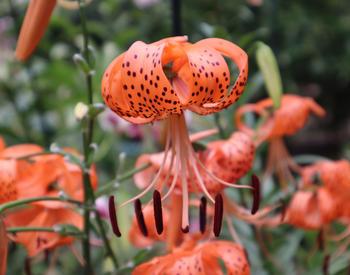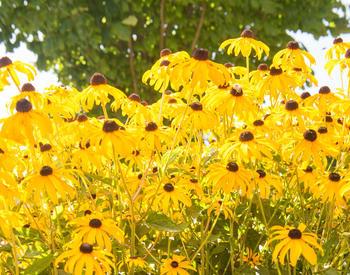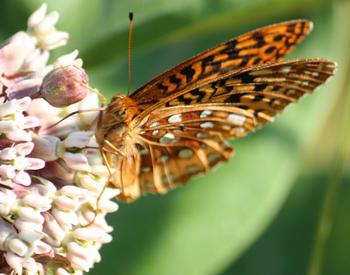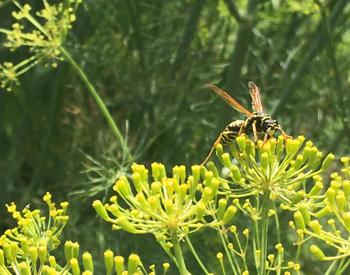Transcript
[00:00:00] Andony Melathopoulo: [00:00:00] You always hear people talk about cover crops and pollinators. It seems to be this big issue and people are really interested in it. Why are cover crops important for pollinators and, what kind of role can they play? And tell us a little bit about some of the gaps around here in Western Oregon when actually putting cover crops in for pollinators.
[00:00:22] Rebecca Sweet: [00:00:22] Sure, yeah. Well, cover crops have been around for a long time. And you know, at first it was all about soil conservation and then it was about fertility and people realized then that cover crops could help break up disease cycles. All the research has been about cover crop role and agronomy and soil conservation.
[00:00:46] Andony Melathopoulo: [00:00:46] I should just stop you for a second. For people who don't even know, what is a cover crop? What do people mean by that traditionally?
[00:00:55] Rebecca Sweet: [00:00:55] Yeah, yeah. So that's kind of what I was starting with there. It's basically [00:01:00] something that's grown that doesn't have a cash value. You know, people aren't going to be harvesting cover crops usually, for money. You know, it's something that can be used to fix nitrogen in the case of legumes, like clovers and vetches and peas. So, they fix nitrogen from the air with a symbiotic relationship with bacteria, and their roots fix atmospheric nitrogen into the soil. And so it basically is like free nitrogen. And so that has been a big role of cover crops. And then back in the Dust Bowl days, they realized that leaving soil uncovered is a bad idea. Soil loss continues to be a problem worldwide, but historically has been a major issue. Our technologies have gotten [00:02:00] better, and cover cropping is catching on, for those goals. So yeah, that's a cover crop.
[00:02:05] Andony Melathopoulo: [00:02:05] Okay. So, traditionally it had these two roles of soil health and soil retention, and now, pollinators are this new thing that people have been thinking about?
[00:02:16] Rebecca Sweet: [00:02:16] Right? Yeah. It's sort of come to light obviously, that pollinators have a major role in our ecological picture for multiple reasons, not just that conservation reason in general, but human needs to produce food for ourselves. And so that gives them, you know, the spotlight that you're putting on them, that is well deserved. And cover crops certainly can fill a major empty [00:03:00] void - provide a resource for cover for pollinators because all the flowering ones, outside of grasses. When I think of flowering cover crops, I think of clovers, for example. And all of the legumes that I mentioned earlier, have resources for pollinators such as nectar and a lot of them have pollen that can sustain pollinators.
[00:03:29] Andony Melathopoulo: [00:03:29] So, at the same time as they're doing these other things, like improving soil health and, holding on to soil they can also be going to flower. Some of these areas can be quite large, they get a big block of flowering plants suddenly in a landscape, which may not have been there.
[00:03:49] Rebecca Sweet: [00:03:49] Absolutely, yeah. Cover crops historically have been grown in monocultures, more recently mixes have been used and usually they're a mix [00:04:00] of some sort of a cereal grain and then legumes. The cereals tend to have more soil building properties. So, you know, those grasses hold the soil. And you can imagine a root system of a grass is very fine and a huge network of deep roots that, just build soil structure. And then you mix in with that some other species usually legumes cause most farmers are looking for some sort of a nitrogen input, depending.
[00:04:35] And so then you can start playing with the species. "What are those species?" And think about pollinators when you're choosing those species. For example, a lot of vetches, have something called extra floral nectaries. So, that just means that the nectar is born on the outside of the flower, so [00:05:00] that any little tiny bodied insects can access that nectar. It doesn't have to be a large bodied insect to work a giant complicated flower, or have a special long tongue to reach to the bottom of the flower where it's hiding its precious nectar.
[00:05:20] Andony Melathopoulo: [00:05:20] Okay, okay. That's great. So these plants can serve a whole broad range of pollinators and I guess, thinking about cover crops and their implementation in Western Oregon - where are some of the places that cover crops are, and what are some of the limitations to, you know, making more of them into pollinator habitat?
[00:05:46] Rebecca Sweet: [00:05:46] Yeah, well, there's a lot of opportunities to establish cover crops for pollinators in Western Oregon. You know, we're blessed with a lot of rain, and so that [00:06:00] means that we're less needful of supplemental irrigation. So that means that we can throw down a diverse cover crop mix on headlands, for example. And so when I mean a headland, I just mean like for example, in a brand new development of a brand new vineyard, for example, which is where most of my career has been. You could throw down instead of just the grass seeds, you could throw down a diverse mix of seeds and, establish that with just the rainfall that's going to be coming in October, for example.
[00:06:46] So, you could throw that down in September and know that you're reliably going to get decent temperatures for germination along with some soil moisture. So yeah, Western [00:07:00] Oregon and cover crops are just married, they're meant for each other - it's not hard. The challenge here is too much water, sometimes. So, there's just some cover crop species that don't do well with wet feet. Also, you know, hitting that window of time where you can get out onto the field before it's too wet and yet have enough temperature to germinate.
[00:07:37] Andony Melathopoulo: [00:07:37] This did come up in the episode with Dr. Serkan Ates and he was talking about a number of leguminous species, for example, that really didn't tolerate water logging and others that did. So that kind of excluded a number of species because a lot of places in Western Oregon - that field may be partially underwater for a little bit of time.
[00:07:58] Rebecca Sweet: [00:07:58] Right? And, and also if [00:08:00] you want to get onto a field early in the spring now and thinking about more vegetable systems, you may not want the water holding capacity that cover crops bring. So, you know, they do a great job of retaining water in a field. So, if you want to be able to get out onto a field early in the spring, you may not want to have a big giant grass, legume cover crop to manage. So, in that case, you could maybe just choose species that are shorter. But yeah, that's a factor for a lot of farmers, finding, you know, cover crop mix that fits their cropping calendar schedule and crop rotation.
[00:08:52] Andony Melathopoulo: [00:08:52] Now you have a background here at OSU working in cover crops in vineyards specifically. Can you just maybe walk [00:09:00] us through how vineyards are using cover crops?
[00:09:04] Rebecca Sweet: [00:09:04] Yeah, sure. So, you know, it kind of goes back to that irrigation situation we talked about earlier. Generally I think this is still true in the past, said that about 50% of Western Oregon vineyards are non-irrigated. And a lot of them choose not to use irrigation even if they have it in place. So that just means that, you know, the things that we're putting down on the ground for cover crops are not going to be irrigated. But when it comes to what we choose to put on the ground, it's going to be a matter of, how old the vines are - because the older the vineyard is, the more deeply rooted it is and the more tolerant it is of the competition that [00:10:00] the cover crop is going to put upon that vineyard.
[00:10:05] Andony Melathopoulo: [00:10:05] Because the cover crop is going to be planted in the rows between. So their roots may compete for the moisture with the roots of the crop
[00:10:16] Rebecca Sweet: [00:10:16] Right, absolutely. And in the case of vineyards, it can be a good thing because we in the wine industry are trying to grow a very high quality product. We're not necessarily trying to grow a very high yielding product. Now, that's not always true, but generally an Oregon Pinot noir, we're going for a premium product and so yields are less important compared to quality. So, in that case, we want to oftentimes ratchet down the vigor of the vineyard. So, depending on how deep your soils are, you may want to establish a cover crop that is competitive. [00:11:00] So in that case would be, perennial grass based. And there's lots of opportunity to throw in flowering species in that kind of a mix. And if you don't have an old deeply rooted vineyard and you have a young establishing vineyard, you would not want to have a competitive vineyard floor, so you would have more cereals in a traditional cover crop mix.
[00:11:28] Andony Melathopoulo: [00:11:28] Okay so, those grasses are, I'm gathering are very good at gathering moisture. If you were in an established orchard, the kind of cover crop you're looking for is primarily grass. And I did hear you sort of say, that, that does have some opportunities for pollinator plants. Obviously the grasses aren't pollinator plants. Tell us a little bit about, how that would work.
[00:12:00] [00:12:00] Rebecca Sweet: [00:12:00] Well, yeah. I mean, the perennial grasses that are deeply rooted and, competitive would be more competitive, and then there are perennial grasses that are not so deeply rooted and essentially just go dormant in the summer. Now they don't look beautiful and green in the summer because they're not deeply rooted, but they don't die. And they still provide function in terms of supporting the weight of your tractor and, providing a nice place for your workers to walk. So, I just wanted to make sure that you understoon that there are different types of perrenial grasses.
[00:12:38] Andony Melathopoulo: [00:12:38] I didn't understand it and I don't know for sure the listeners did. So, there are some grasses that are going to just be this nice green carpet. And there are some grasses that are not as deeply rooted whose strategy it is when they hit that hot summer, they'll dry down - but they still provide that [00:13:00] nice, support during the wet season. So, when you're going through the vineyard, the tractor can be supported when it's wet. That's great. That's a good distinction. So there are these two kinds of contexts in vineyards, and I imagine they offer different opportunities for pollinator plants. If you have a deep rooted perennial that's going to be green the whole time that's a different perhaps context for incorporating pollinator plants and one that's shallow rooted in dormant in the summer?
[00:13:33] Rebecca Sweet: [00:13:33] Yeah, I think so. I think in general though, the more important aspects to the floral part of what goes in a vineyard is going to be stature and tolerance to traffic and the droughty condition. Because, you know, we want really good wind flow through the vineyard and we want to be able to have a flowering [00:14:00] species that is going to flower low, right? So it's not going to be in our way, otherwise we're going to be driving over it and it's just going to get mashed by the tractor essentially and - nobody can walk down the alleyway if you have golden rod that's up to your armpit. Right? So, you need species that are inherently short or will still be functional in terms of a floral resource after mowing. So some species of flowering plants will still bloom after you hack their heads off at eight inches. So...
[00:14:36] Andony Melathopoulo: [00:14:36] But others won't. They come up and then they're dead after that point -you've terminated them. In all cases, whatever the ground cover, you can't have something that's tall because it is going to get in the way. But you also mentioned airflow that, if it grows up a ways, then the air flow through the vineyard will be [00:15:00] decreased, which I imagine leads to disease problems or other kinds of problems.
[00:15:05] Rebecca Sweet: [00:15:05] Yeah, fungal problems. Mostly we're combating powdery mildew in vineyards and also botrytis. And so those are our main, fungal enemies in the vineyard and, airflow is always going to help that situation. So earlier we talked about some obstacles to cover cropping and that's something else I didn't mention is frost. So, in the spring time sometimes our cover crops can get up quite large and that can obstruct airflow. As air drains from the top of the hill to the bottom, which is what you want to reduce frost pressure. So, that can be an argument against cover cropping as well. So again, just thinking more about stature of your species more than [00:16:00] any other things sometimes - it's definitely up in the top things to consider.
[00:16:05] Andony Melathopoulo: [00:16:05] This sounds so complicated. People often start with plant lists, it's like, "what's the best plant for pollinators?" But in some ways, I think your approach and Buzz Cover Crop your company's approach is - it's not so much whether the plant is the most superior to pollinators or not. Well, that is a consideration, but also can they fit in this constrained system? Because I imagine if it didn't, then nobody would adopt it. It wouldn't serve the function that these grape growers are looking at.
[00:16:42] Rebecca Sweet: [00:16:42] Exactly. It has to fit the system, otherwise people are not going to adopt it. So you really have to think about what the objective is on that farm. You know, there's people I'm talking to right now that are organic growers, and they're trying to battle pests with [00:17:00] insectary plants. So, you know, those people are on board, they're thinking about, you know, diversity and how to use it to their benefit in their system. But then you have other people that are just putting down grass because that's what they know they need to do, but they don't see that there's an opportunity to enhance habitat right there in front of them.
[00:17:26] And so what I'm trying to do is just provide a product that they can reach for easily that's gonna fit their system. I've developed a pretty good mix for vineyard floors, which could easily be put down on any other headland space in any other perennial system or annual. So when I say headland, I mean areas around the orchard or the berry field or the vegetable fields that you use for driving on, road surfaces that are [00:18:00] grass on farms or areas that are used exclusively for harvest equipment once a year. But you have to have that staging area, you know, for your crews to park in and for your truck to be loaded. So, typically those are grass and they're mowed during the year and they're used for a few weeks and that's it. Well, the rest of the summer, they can be used by pollinators and other beneficial insects.
[00:18:28] Andony Melathopoulo: [00:18:28] That is fantastic. It's a really a great marriage of, using space wisely. But I imagine to come up with these kinds of systems you have to know those systems as well. Like, one has to sort of like know how the farm works before you can even start to think about coming up with a seed mix like this. Otherwise, I think a lot of us have had the experience of trying to promote pollinator mixes and not understanding the system. And [00:19:00] frustrated that the adoption rates are not that high.
[00:19:05] Rebecca Sweet: [00:19:05] There's a lot of factors, you're right. Farming is complicated - it can be. And, ecological farming practices are even more complicated. And I think that, you know, they're sophisticated. And I think that, the draw, you know, it's exciting and interesting. You know, that's why I know so many PhD's that went back to farming. There's nothing more interesting or complicated than this. I just have so much respect for the farmers that I know that our ecological system in their systems on their farms with goals in mind.
[00:19:48] And so, yeah, I mean, you have to think about equipment, for example. That's, you know, definitely something that people, have or they don't. [00:20:00] And if they don't where can they get it. Can they get it? You know, water systems? Weediness, that's another factor you know, do you have herbicides available on your farm? Or do you not? If you're certified organic, you may not. So, you know, these are all factors to consider when you're choosing cover crop species.
[00:20:25] Andony Melathopoulo: [00:20:25] Well, I think that's a fantastic transition. Let's take a quick break and let's come back and talk about those. Becuase I imagine for a lot of our listeners are people with small farms. But as you pointed out, some of these same practices could be used anywhere you're going to be running machinery over, or you have a lawn or something. Let's take a quick break, let's, come back and talk about some of these considerations in terms of establishment and maintenance of this kind of pollinator habitat.
[00:20:56] Okay, great. Well that was a great break. I'll [00:21:00] always love the conversations at the break. I'm so sad sometimes the listeners can't eavesdrop on us. But anyways, we're back. Part of the thing that we were talking about was - let's say you're a vineyard grower and you want to put pollinator habitat in and you've already kind of constrained the problem, the place it's going to need to go is in the rows. What are some of the considerations of getting it established? Is it just a matter of like getting a seed pack and just sprinkling it in the grass and hope for the best, or what do they have to keep in mind?
[00:21:42] Rebecca Sweet: [00:21:42] Knowing what the plant right. I've taken the last twenty years looking around and you know, to think about what would fit into in a vineyard alleyway system, you know, and provide rural [00:22:00] resources. Because we do mow it and we need to mow it, because we drive up and down these hills. We don't want them to catch on fire because they're, you know under our running tractors - that's a serious consideration. So just knowing what to plant is a mystery to a lot of people. You know, they're busy farming their crops, and a lot of them have other jobs too. So, making wine or selling wine, and it's busy! So, thinking about, what's growing on your floor is, you know, a minor consideration.
[00:22:38] So, I have just now provided this Pollinator Pathway mix to people this past year and before that, there really wasn't anything to reach for on the shelf, so to speak. So knowing what to plant is a major obstacle. And then finding the seed. If you did know what to plant, you know, a lot of [00:23:00] these flower seeds are really hard to find. You can't just call up, you know, the local farm supply and say, can you get me three pounds of alyssum? You know, it's not really the easiest thing to find some of these native flowers, horticultural flowers in the volumes that we need them. And then you want to mix them into your grasses that you can find off the shelf, so to speak. So, all those things.
[00:23:34] Then you need equipment, you need a specialized equipment for seeding. Could you walk through and broadcast it out of a bucket and then kind of tickle it in with some sort of a harrow? Yeah, you could. Ideally though, you drill it, and so that's a specialized piece of equipment.
[00:23:52] Andony Melathopoulo: [00:23:52] For our listeners, what is a drill?
[00:23:57] Rebecca Sweet: [00:23:57] So seed drills are [00:24:00] built to be pulled with an implement, they go on a back of a tractor, right? Just like you would put a cultivator or a mower, you could put a seed drill and you can calibrate them to drop the seed at a certain rate. So, that would depend on how heavy you want it and how big your seed is. And it put drills, it has little disks that part the soil and push the seed down to whatever depth you set your drill at. So, that it's actually sewing the seed under the ground. And that's ideal because then you have good seed-soil contact for germination, right? It's going to be kept moist instead of just drying out on a surface. It won't be eaten by birds and beetles on the surface.
[00:25:00] [00:24:59] So you can get away with a lower seed rate if you're drilling it in. You could broadcast it, there's some sweatersthat will sort of just toss the seed out and then in that case, you'd want to come again behind that pass with something that would, you know, kind of incorporate it down into the soil ideally. And there's different kinds of drills, there are no-till drills, there are drops seeders, also which is kind of like a broadcast. So yeah, lots of different ways to get seed in the ground, but a lot of vineyardists at least don't necessarily have that. There are companies in Oregon that will rent seed drills and some of the conservation organizations districts have seed drills that they will lend you
[00:25:57] Andony Melathopoulo: [00:25:57] But they are often in high [00:26:00] demand. We've got one for the county often, and they're not super available.
[00:26:08] Rebecca Sweet: [00:26:08] Correct. Yeah, you have to get on the list, it's on a calendar and it's a tight window of time. I mentioned earlier that September, mid to late September is really the ideal time to sew and this last fall we had this luxurious planting window because it just didn't rain, it didn't rain and it didn't rain. So, we had good planting conditions through October really.
[00:26:33] Andony Melathopoulo: [00:26:33] So let me get, get this straight. With these drills, if you had an established perennial grass row, you would just go through and you would put the seed at the right depth through the grass, or would you have to get rid of the grass? And I imagine there's two settings, one is an established orchard with it's perennial grass in place and you're setting up a new [00:27:00] orchard. I imagine those are two different issues.
[00:27:03] Rebecca Sweet: [00:27:03] It could be. I mean, it has more to do with the competitive aspect of the grass, than like what floor actually looks like in the germination setting. So what you're describing with getting flowering species into grass is more of what I would call overseeding situation. So, that's not so common. It can be successful, but can be hard to establish something right next to an aggressive, well-established grass.
[00:27:41] Andony Melathopoulo: [00:27:41] Okay.
[00:27:41] Rebecca Sweet: [00:27:41] So whatever you're putting in the ground has to have high seedling vigor, in order to succeed in that kind of environment. But, it is done in the Midwest and for conservation. So, [00:28:00] more commonly if people want to redo their floors, often you get gophers working up the floors, or you get ruts that happen from just driving on wet ground. And every once in a while people will just rework the floor to make it smooth again.
[00:28:19] Andony Melathopoulo: [00:28:19] Oh I see, okay.
[00:28:21] Rebecca Sweet: [00:28:21] So that will provide you an opportunity to put down a new mix of seed, and start anew. And so, you know, a lot of times a common practice in vineyards is to have alternate row management - where every other row will be cultivated every year. Just to back off the degree of competition that's happening in the vineyard.
[00:28:51] Andony Melathopoulo: [00:28:51] Earlier in the interview, you were talking about how the grass is a needed competition, but you may have just too much. So you would work up a row and [00:29:00] ease the competition off. I got ya.
[00:29:03] Rebecca Sweet: [00:29:03] Yeah. So, people will alternate, they'll switch which row is cultivated every year, occasionally. So that provides your other opportunity for establishing something new and unique.
[00:29:19] Andony Melathopoulo: [00:29:19] But I imagine something like grass, once you have it in place - it's not just a matter of turning it over, the grass will re-sprout. But there's things that need to be done to kind of get the grass dead.
[00:29:35] Rebecca Sweet: [00:29:35] "Get that grass dead!"
[00:29:39] Andony Melathopoulo: [00:29:39] How's that done?
[00:29:40] Rebecca Sweet: [00:29:40] "Deader, the better." No, that's actually not as hard as you might think. It's pretty easy to cultivate grass and eliminate it through cultivation. Without herbicides, I mean, obviously herbicides are another [00:30:00] tool to do that, but it's really not necessary to employ herbicides on the vineyard or in the alleyways. You can just basically use a disk for example a common cultivation tool. And or, you can rototill and or, you can use a common tool around here it's called a three in one, it's basically like a harrow and a tine that just breaks up the clods and smooths out the surface.
[00:30:32] So, that's a nice one because it's not quite as pulverizing as a rototiller is. Rototilling can really destroy soil structure, so three in one will leave small clods maybe the size of a quarter or something like that, which is preferable to really pulverizing [00:31:00] the soil. Now, if you're putting a fine seed in though like some of these perennial grasses and some of these flowers - a finer seed bed might be justified, but that's not something you do every year.
[00:31:17] Andony Melathopoulo: [00:31:17] Okay, alright. That's a nice primer on the options and trade offs associated with working out the grass and creating the seed bed. And I imagine the second challenge that you've already described as things like the grass may be more competitive and there may be some, forbes that you want to put in that are a little bit more difficult to establish. Putting all the seed down at once must be difficult because you've got these different levels of competitiveness in what you're putting down. How does that get dealt with? Or is it [00:32:00] a concern?
[00:32:01] Rebecca Sweet: [00:32:01] Yeah, it is. It is a concern, you know, with the drill, it's even probably more of a concern because you're putting all of those in little rows down the vineyard floor. Maybe you have, you know, six to ten rows that are maybe four inches apart or so across the vineyard floor. So, all of those seeds are concentrated next to each other in rows. It probably would be less of an issue if it was put down with a drop seeder, for example, or broadcast in some other way - and then incorporated. But that said, you know, the grasses that I've chosen for the Pollinator Pathway mix are clumping grasses, they're not running grasses. And my hope is that by choosing those clumpers, I'm going to leave space for those forbes to establish themselves.
[00:32:59] And [00:33:00] some of the forbes have been already popping up really quick. For example, meadowfoam and salad burnet have been popping up really well. And also the California poppy is very recognizable seedling. So you know, there's some that are gonna come up quick and there's some that are kind of come up later. The birdsfoot trefoil is notorious for being a seedling that has low, low vigor, right? So, although it provides a really great late season flower and it lasts forever once it's established -it might have a hard time in a mix like this.
[00:33:38] Andony Melathopoulo: [00:33:38] I remember the interview with Dr. Ates where he said, you know, "birdsfoot trefoil is one of those perennial legumes that really does better in the second year." It's a slower to establish legume. But I do remember also on some of his plots some of the Megachilidae, the leafcutting bee family really liked it a lot. [00:34:00] So getting it to establish and obviously bumblebees, but I really noticed some of the bees in the leafcutting family really loved visiting the trefoil.
[00:34:11] Rebecca Sweet: [00:34:11] Nice. Well, I do hope to see it in this mix, if not this year, then next. And I think that's kind of true for a lot of species in college and grad school, I worked with Roemer's fescue and it's just a slow grass. A lot of these fine fescues are slow grasses and both of the grasses in my pollinator pathway are fine fescues and are slow. And so it's going to take a couple years for this pathway mix to really fill in and look like we want it to. And that's just kinda the way it is, we could experiment with some nurse craft I suppose and get some faster annuals in there that'll just peter out, and that's definitely worth [00:35:00] experimenting with.
[00:35:01] Andony Melathopoulo: [00:35:01] It sounds like in vineyards specifically, there's this fine balance between, you know, being competitive and stressing the plants out slightly. We've often heard that leguminous plants can sometimes attract things like voles. But the other thing I'm mindful of is in vineyards, this delicate balance between moisture. I imagine nitrogen fixing must be one of those things that need to be taken into account. Tell us a little bit about, leguminous plants in rows and orchards and vineyards.
[00:35:34] Rebecca Sweet: [00:35:34] Sure, yeah. Vineyards need nitrogen just like every other plant in these sites, but again, back to the goal in wine grapes is different from most other agronomic systems in that we are looking for a quality product and not a high yielding product. So our nitrogen needs are going to be much lower. We don't want to have a very [00:36:00] vegetative vine that's going to be dense, and shady and stop air from flowing through it. So, in that case, we want to optimize the amount of nitrogen that we have - we don't want to have too much.
[00:36:22] So in that case, I do discourage planting perennial legumes or legumes that perennialize, you know, like a sub clover would function like a perennial because it sulksthose and just reestablishes itself. So because then you don't have control over how much nitrogen is being provided by that legume. Now, do we have "natives", which are essentially residential [00:37:00] legumes in our vineyards? Yes, a lot of these were you know, grazed in the past, these hillsides, you know, were sewn, you know, by our forefathers to legumes. Or they just got there somehow and now they're there and there's not much we can do about that.
[00:37:17] But in terms of putting new seed of legumes in the ground, I do make sure people are aware of, you know, how much they can provide to the system. It's not to be under estimated and you know, we can provide nitrogen to grapes in other ways with fertilizers, foliar and on the ground when they need it, and how much they need to a much higher degree of specificity.
[00:37:55] Andony Melathopoulo: [00:37:55] Okay, that's fantastic. Well, this sounds like a fascinating venture, and so [00:38:00] you've got some seeds in the ground, so you're testing out some of these mixtures. Tell us a little bit about some of the experiments you have in the ground and what's the future for Buzz Cover Crop seeds?
[00:38:14] Rebecca Sweet: [00:38:14] Yeah! Well, I sold quite a bit of my Pollinator Pathway, which was sort of my debut seed mix last year to Western Oregon Vineyards - Left Coast is the one that's closest to me that I've been able to check out. I've been watching, you know, what's coming up and talking about how they put it in the ground. And I just honestly have been hunkered down like a lot of other people and haven't been out as much as I had intended to this spring. But, it certainly is time to get out and look around some more at, at this Pollinator Pathway to see how it's doing - make some phone calls. And I did hit the ground a little bit late [00:39:00] in the season last year - it was hard to find a lot of these flower seeds. And so there was wider interests, in the mix than was actually purchased because people had already purchased their perennial seeds for the year at that time.
[00:39:15] So I'm really hoping that even more people, will adopt this seed mix in their vineyards this year. Besides that, I'm providing, as I mentioned earlier, some insectory mixes for people that have, conservation biocontrols or biocontrol objectives on their farms. I'm working with an organic leek grower up in the Skagit Valley and some hops growers also up there looking for some plants to support their beneficial insects, their natural enemies.
[00:39:53] So beyond pollinators and, also putting together some really [00:40:00] exciting pasture mixes working with a seed company here, near Corvallis actually, that has decades of experience growing pastures for mostly beef cattle, but also, sheep. And so really just thinking about optimizing seed mixes for this Willamette Valley that are multifunctional, you know, that can be grazed, nutritious, holistic nutrition for livestock. You know, there's plants that animals can graze that will help them with their internal parasites, for example.
[00:40:39] So really thinking about the big picture of your farm and, you know, getting those kinds of plants in your pasture as well as plants for pollinators. We can serve so many functions with every action that we do on the farm if you just think about all the ways that it can be effective. I have a [00:41:00] consulting business also, called Corridor Ag Land Consulting and I've been working under that for many years before Buzz Cover Crop Seeds came around and have in that context, done some consulting on hedgerows and, you know, multifunctional hedgerows are really a great opportunity to improve diversity on farm. In the LIVE program - so I've been doing inspections for LIVE, Low Input Viticulture and Enology.
[00:41:35] Andony Melathopoulo: [00:41:35] That's great. We just had Ron Bitner, who is a Idaho live grower was on a couple episodes ago. Remind us a little bit about LIVE and tell us a little bit about it.
[00:41:47] Rebecca Sweet: [00:41:47] Yeah, Ron is great, what a great entomologist he is and, a great viticulturalist as well, and kind of a pioneer out in Idaho there - in [00:42:00] the viticultural world. Hedgerows and LIVE came up together because there's a requirement in the LIVE program that 5% of your entire farm holding is an ecological set aside - and that's the requirements. You can't plant your entire farm edge to edge with grapevines and be LIVE certified. So, I think that's just outstanding and unique among farm certification.
[00:42:38] And, oftentimes when there's little room to scrape out that 5% on the farm because the vineyard already been established and then they come to the program and go, "oh, I really don't have 5%, you know, maybe I've got four, four and a half." Then we start talking about hedgerows because you can take up that [00:43:00] vertical space with floral resources, right? Then we're talking about surface area, we're not talking about floor acreage, and that's the conversation that continues to evolve in a LIVE program.
[00:43:15] So that's pretty exciting. I love to see how the direction that this is going in there. The LIVE program and in this past two or three years has really done a lot of work on creating an ecological tool that is like a self assessment tool - where people can have a look at their farm and ask themselves a set of questions in order to assess what their ecological, resources are. And so, yeah, pretty proud to be part of that program.
[00:43:50] Andony Melathopoulo: [00:43:50] Well, fantastic. I think you've given us all of us stuck at home some really great ideas. I imagine some of these same principles can be used in all sorts of different [00:44:00] farms, but probably, you know, grass grows on lawn. So there's all sorts of ways these ideas can come into play. Thanks so much for taking time to bring us up to speed on all this fascinating and very kind of nuanced world of doing pollinator plantings and vineyards.
[00:44:20] Rebecca Sweet: [00:44:20] Absolutely, my pleasure Andony. Thanks for inviting me!
Creating pollinator habitat on farms is not as simple as it sounds. To be successful the habitat has to integrate into the cropping system and have low establishment and maintenance costs. In this episode we hear about efforts to strike this balance in Oregon vineyards.
Rebecca Sweet is the founder of Buzz Cover Crop Seeds, which provides diverse mixes of cover crop, pasture and insectary seeds to small and mid-sized farms in the Pacific Northwest. Rebecca has 16 years of experience researching and applying cover crops in perennial and annual systems in the Willamette Valley.
You can Subscribe and Listen to PolliNation on Apple Podcasts.
And be sure to leave us a Rating and Review!
Links Mentioned:
- OSU Pollinator Stewards Program
- Buzz Cover Crop Seeds
- Left Coast Vineyard
- Corridor Ag Land Consulting
- LIVE, Low Input Viticulture and Enology
Rebecca Sweet's Go-To-Tools:
- Drop seeder
- Rototiller
- Harrow
- Three in one

